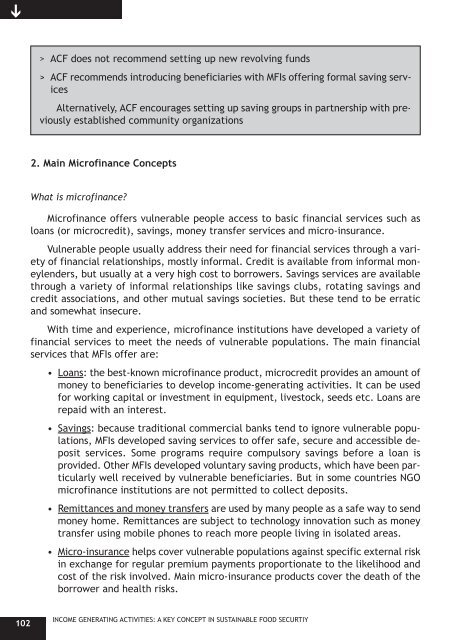Income-Generating Activities - Action Against Hunger
Income-Generating Activities - Action Against Hunger
Income-Generating Activities - Action Against Hunger
Create successful ePaper yourself
Turn your PDF publications into a flip-book with our unique Google optimized e-Paper software.
➔<br />
> ACF does not recommend setting up new revolving funds<br />
> ACF recommends introducing beneficiaries with MFIs offering formal saving services<br />
Alternatively, ACF encourages setting up saving groups in partnership with previously<br />
established community organizations<br />
2. Main Microfinance Concepts<br />
What is microfinance<br />
Microfinance offers vulnerable people access to basic financial services such as<br />
loans (or microcredit), savings, money transfer services and micro-insurance.<br />
Vulnerable people usually address their need for financial services through a variety<br />
of financial relationships, mostly informal. Credit is available from informal moneylenders,<br />
but usually at a very high cost to borrowers. Savings services are available<br />
through a variety of informal relationships like savings clubs, rotating savings and<br />
credit associations, and other mutual savings societies. But these tend to be erratic<br />
and somewhat insecure.<br />
With time and experience, microfinance institutions have developed a variety of<br />
financial services to meet the needs of vulnerable populations. The main financial<br />
services that MFIs offer are:<br />
• Loans: the best-known microfinance product, microcredit provides an amount of<br />
money to beneficiaries to develop income-generating activities. It can be used<br />
for working capital or investment in equipment, livestock, seeds etc. Loans are<br />
repaid with an interest.<br />
• Savings: because traditional commercial banks tend to ignore vulnerable populations,<br />
MFIs developed saving services to offer safe, secure and accessible deposit<br />
services. Some programs require compulsory savings before a loan is<br />
provided. Other MFIs developed voluntary saving products, which have been particularly<br />
well received by vulnerable beneficiaries. But in some countries NGO<br />
microfinance institutions are not permitted to collect deposits.<br />
• Remittances and money transfers are used by many people as a safe way to send<br />
money home. Remittances are subject to technology innovation such as money<br />
transfer using mobile phones to reach more people living in isolated areas.<br />
• Micro-insurance helps cover vulnerable populations against specific external risk<br />
in exchange for regular premium payments proportionate to the likelihood and<br />
cost of the risk involved. Main micro-insurance products cover the death of the<br />
borrower and health risks.<br />
102<br />
INCOME GENERATING ACTIVITIES: A KEY CONCEPT IN SUSTAINABLE FOOD SECURTIY

















